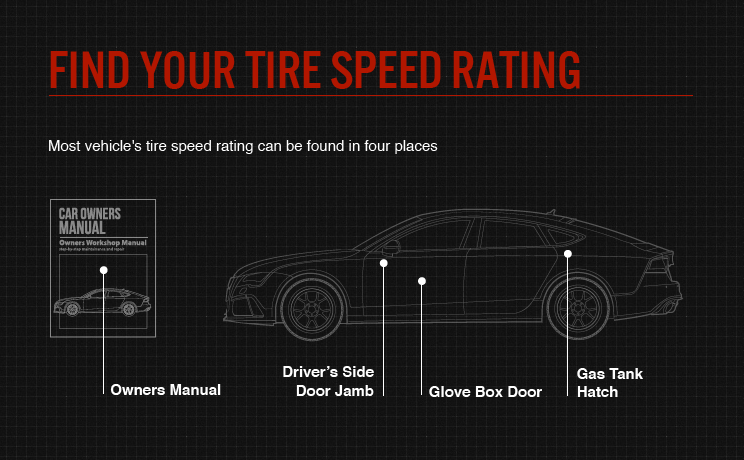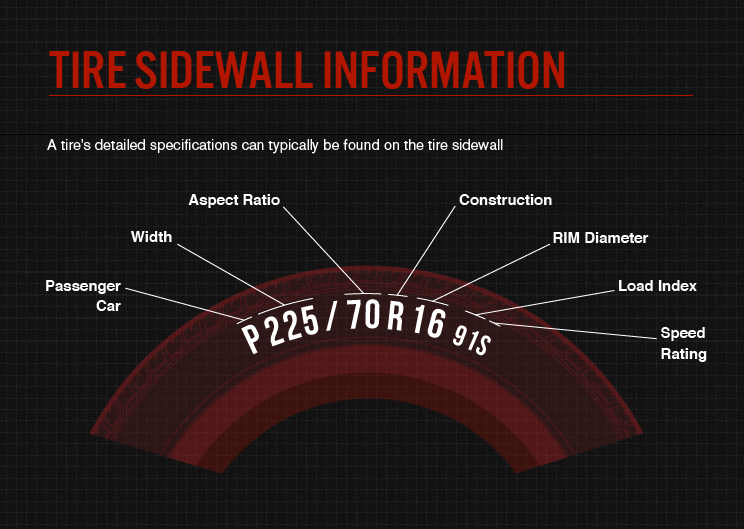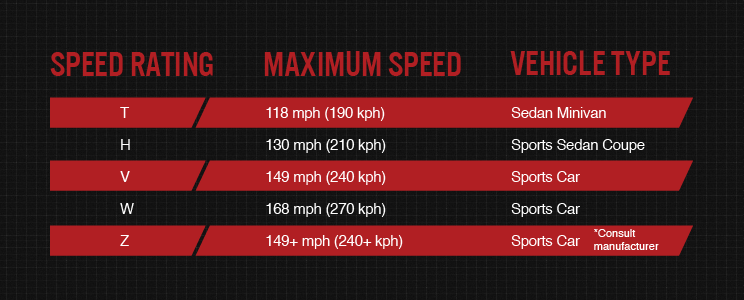Most modern passenger tyres bear a tyire speed rating, a designation indicating the tyre’s designed speed capability. In other words, it’s the fastest speed a tyre can handle before it does not perform as designed. Tyre speed ratings do not imply that the vehicle may safely be driven at the maximum speed for which the tyre is capable, particularly under adverse weather or road conditions.
How to Find Your Tyre Speed Rating
If you’re wondering what tyre speed rating your vehicle manufacturer recommends, simply look in the manual. You might also find it in the driver’s side door jamb, the petrol tank hatch, or inside the glove box compartment – anywhere that lists the right tyire code for your vehicle.

Speed rating is easy to locate because it’s usually the last item in the character sequence in the tyre’s size code. For example in this tyire code: “205/60/R16 82S,” S is the speed rating. To view the tyre size code for your current tyres, just look at the sidewall. Does the speed rating on each tyre match what the manufacturer recommends? It should!

Also remember that the tyre speed rating isn’t the same thing as a recommended travel speed. The rating will nearly always exceed maximum highway speed limits, but no tyre or vehicle manufacturer advises driving faster than the law allows.
Determining Tyre Speed Rating
Speed ratings are the product of laboratory testing – with simulated speeds and loads. To receive any kind of rating, a tiyre must demonstrate that it’s capable of sustaining a particular speed. Industry standards govern the process of reaching and maintaining a given speed during a test.
However, it’s important to remember that the lab can’t simulate every conceivable condition. Think of your tyre’s speed rating as an indicator of the product’s capability under controlled conditions (i.e. fully inflated, vehicle running properly, good weather conditions). Your tyres’ actual speed capability may be less than its rated speed, since it is affected by factors such as inflation, wear, vehicle condition (including wheel alignment), driving conditions and the duration at which speed is maintained. Speed ratings do not apply to tyres that have been damaged, altered, under-inflated, overloaded or repaired.
Tyre Speed Rating System Quirks and Anomalies
Today’s speed rating system uses letters A through Z. Each letter corresponds to a specific speed. In general, that speed goes up as the rating advances alphabetically. For example, a tyre rated “L” is good for a lower maximum sustained speed than one rated “N.”.
But the tyre speed rating system isn’t without its quirks. For instance, the system’s European roots give it unusual kilometres per hour maximums. Another such quirk is that the letter “H” is out of place. Instead of appearing after “G,” it falls between “U” and “V” as does the speed to which it corresponds.
Additional speed rating “anomalies” include the following:
- “I,” “O,” and “X” speed ratings don’t exist. Likewise, some speed rating charts don’t include the “P” rating.
- Tyres with the lowest speed ratings are usually listed as “A” followed by a number– for example, “A1,” “A2, “A3,” and so on.
- Some tyres carry “W” or “Y” speed ratings. Manufacturers may also insert “Z” into the size description (in the tire code data between aspect ratio and diameter) for these kinds of tyres.
When the speed rating system was first developed, the highest speed rating was the unlimited “V” rating. This was for tyires whose maximum sustained speed was 149 mph (240 kpm/h) or more. Then, as more manufacturers came out with tyires that could handle speeds in excess of 240 km/h 149 mph but still hit a maximum speed at some point, “V” became limited (240 km/h149 mph instead of 149+ mph) and “W” and “Y” speed ratings were added to the chart.
Many tyire speed rating charts also list the “Z” rating as anything over 240 km/h149 mph. Some manufacturers will insert a “Z” in the middle of the tyire size description (right after the aspect ratio) when the tyire is rated at “W” or “Y.” And if a tyire is rated in excess of 186 mph (300 kpm/h), manufacturer’s usually will list a “Z” within the size description, per industry standards.
Common Tyre Speed Ratings Chart
The following speed ratings are those you’re most likely to encounter for ordinary vehicles. They begin with a maximum speed of 118 mph (190 kpm/h) and increase from there.
Indicated by a letter, each rating corresponds to a specific speed.

Speed Rating T
With a maximum speed of 118 mph190km/h, you usually find tyres with speed rating “T” on family sedans and minivans.
Speed Rating H
If you recall from earlier, the “H” speed rating doesn’t appear after “G” but between “U” and “V.” It represents a maximum speed of 210 km/h and is commonly found on sports sedans and coupes. In earlier incarnations of the speed rating system, “H” stood for “high performance,” which is why it maintains an unusual position in the speed rating spectrum today.
Speed Rating V
Once the highest speed rating a tyre could have, “V” used to represent a maximum of 240 km/h or more. Nowadays, it means 240km/h but no higher.
Speed Rating W
A relatively new addition to the speed rating chart, tyires with speed rating “W” can achieve a maximum sustained speed of 270 km/h.
Speed Rating Z
A “Z” rating can mean different things. While it nearly always means a high performance tyre for high-performing sports cars, “Z” may actually appear in the middle of a tyre’s size information. When it does, it represents either a maximum speed of more than 240 km/h or 300 km/h. Which of those speeds it refers to will depend on the specific tyre. Contact the manufacturer to get details on any Z-rated tyres. Sports car owners are more likely to encounter this speed rating than owners of typical family sedans.
Always choose the speed rating that corresponds to your vehicle manufacturer’s specifications, and be sure all four tyres have the same rating. Speed ratings are based on laboratory tests under specific, controlled conditions. While these tests relate to performance on the road under those conditions, remember that real-life driving is rarely identical to test conditions.